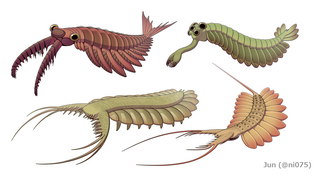
Dinocaridida is a proposed fossil taxon of basal arthropods that flourished in the Cambrian period with occasional Ordovician and Devonian records. Characterized by a pair of frontal appendages and series of body flaps, the name of Dinocaridids refers to the suggested role of some of these members as the largest marine predators of their time. Dinocaridids are occasionally referred to as the 'AOPK group' by some literatures, as the group compose of Radiodonta, Opabiniidae, and the "gilled lobopodians" Pambdelurion and Kerygmachelidae. It is most likely paraphyletic, with Kerygmachelidae and Pambdelurion more basal than the clade compose of Opabiniidae, Radiodonta and other arthropods.

Anomalocaris is an extinct genus of radiodont, an order of early-diverging stem-group arthropods.
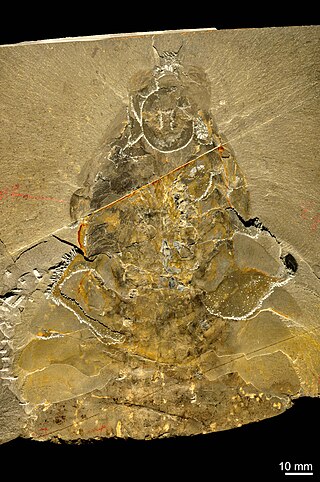
Peytoia is a genus of hurdiid radiodont, an early diverging order of stem-group arthropods, that lived in the Cambrian period, containing two species, Peytoia nathorsti from the Miaolingian of Canada and Peytoia infercambriensis from Poland, dating to Cambrian Stage 3. Its two frontal appendages had long bristle-like spines, it had no fan tail, and its short stalked eyes were behind its large head.

Anomalocarididae is an extinct family of Cambrian radiodonts, a group of stem-group arthropods.

Parapeytoia is a genus of Cambrian arthropod. The type and only described species is Parapeytoia yunnanensis, lived over 518 million years ago in the Maotianshan shales of Yunnan, China. Unidentified fossils from the same genus also had been discovered from the nearby Wulongqing Formation.
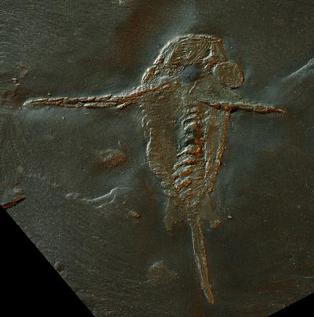
Schinderhannes bartelsi is a species of hurdiid radiodont (anomalocaridid) known from one specimen from the lower Devonian Hunsrück Slates. Its discovery was astonishing because previously, radiodonts were known only from exceptionally well-preserved fossil beds (Lagerstätten) from the Cambrian, 100 million years earlier.

Radiodonta is an extinct order of stem-group arthropods that was successful worldwide during the Cambrian period. They may be referred to as radiodonts, radiodontans, radiodontids, anomalocarids, or anomalocaridids, although the last two originally refer to the family Anomalocarididae, which previously included all species of this order but is now restricted to only a few species. Radiodonts are distinguished by their distinctive frontal appendages, which are morphologically diverse and used for a variety of functions. Radiodonts included the earliest large predators known, but they also included sediment sifters and filter feeders. Some of the most famous species of radiodonts are the Cambrian taxa Anomalocaris canadensis, Hurdia victoria, Peytoia nathorsti, Titanokorys gainessii, Cambroraster falcatus and Amplectobelua symbrachiata, the Ordovician Aegirocassis benmoulai and the Devonian Schinderhannes bartelsi.

Hurdia is an extinct genus of hurdiid radiodont that lived 505 million years ago during the Cambrian Period. Fossils have been found in North America, China and the Czech Republic.

Stanleycaris is an extinct, monotypic genus of hurdiid radiodont from the middle Cambrian (Miaolingian). The type species is Stanleycaris hirpex. Stanleycaris was described from the Stephen Formation near the Stanley Glacier and Burgess Shale locality of Canada, as well as Wheeler Formation of United States. The genus was characterized by the rake-like frontal appendages with robust inner spines.

Caryosyntrips ("nutcracker") is an extinct genus of stem-arthropod which known from Canada, United States and Spain during the middle Cambrian.
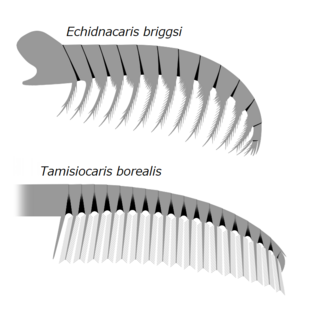
Tamisiocarididae is a family of radiodonts, extinct marine animals related to arthropods, that bore finely-spined appendages that were presumably used in filter-feeding. When first discovered, the clade was named Cetiocaridae after a speculative evolution artwork, Bearded Ceticaris by John Meszaros, that depicted a hypothetical filter-feeding radiodont at a time before any were known to exist. However, the family name was not valid according to the International Code of Zoological Nomenclature, as no real genus named "Cetiocaris" exists, and in 2019 it was formally replaced by the name Tamisiocarididae, after the only valid genus of the clade at the time. The family is only known from Series 2 of the Cambrian, unlike other radiodont families, which persisted longer into the Cambrian. All known species would have lived in tropical or subtropical waters, suggesting a preference for warmer waters.

Hurdiidae is an extinct cosmopolitan family of radiodonts, a group of stem-group arthropods, which lived during the Paleozoic Era. It is the most long-lived radiodont clade, lasting from the Cambrian period to the Devonian period.

Houcaris is a possibly paraphyletic radiodont genus, tentatively assigned to either Amplectobeluidae, Anomalocarididae or Tamisiocarididae, known from Cambrian Series 2 of China and the United States. It contains two species, Houcaris saron and Houcaris magnabasis, both of which were originally named as species of the related genus Anomalocaris. The genus Houcaris was established for the two species in 2021 and honors Hou Xianguang, who had discovered and named the type species Anomalocaris saron in 1995 along with his colleagues Jan Bergström and Per E. Ahlberg.
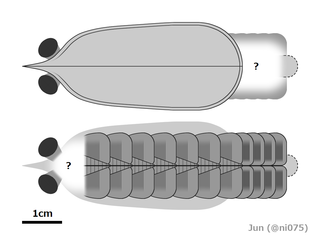
Erratus is an extinct genus of marine arthropod from the Cambrian of China. Its type and only species is Erratus sperare. Erratus is likely one of the most basal known arthropods, and its discovery has helped scientists understand the early evolution of arthropod trunk appendages. Some of the stem-arthropods like radiodonts did not have legs, instead they had flap like appendages that helped them swim. Erratus on the other hand had not only flaps but also a set of primitive legs. It also supported the theory that the gills of aquatic arthropods probably evolved into the wings and lungs of terrestrial arthropods later in the Paleozoic.

Laminacaris is a genus of extinct stem-group arthropods (Radiodonta) that lived during the Cambrian period. It is monotypic with a single species Laminacaris chimera, the fossil of which was described from the Chengjiang biota of China in 2018. Around the same time, two specimens that were similar or of the same species were discovered at the Kinzers Formation in Pennsylvania, USA. The first specimens from China were three frontal appendages, without the other body parts.

Pahvantia is an extinct genus of hurdiid radiodont from the Cambrian. It is known by a single species, Pahvantia hastata, described from Wheeler Shale and Marjum Formation in Utah. Although it was once considered as filter feeder using large number of putative setae, this structures are later considered as misidentification of trunk materials.
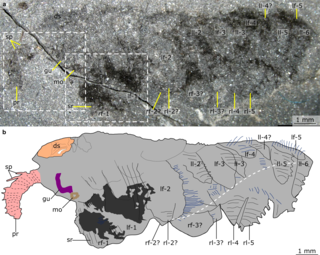
Mieridduryn is a genus of extinct dinocaridid arthropod that lived during the Middle Ordovician of what is now the United Kingdom. This animal was described in 2022 based on a singular fossil found in Castle Bank, a Burgess shale type lagerstätte located in the country of Wales. This animal's taxonomic affinities are somewhat unclear, but there are some hypotheses. One is that this animal represents a new grade of stem-euarthropods that evolved features similar to the Cambrian aged opabiniids. Another is that if the features seen in Mieridduryn are convergent, and not homologous, to those seen in radiodonts, then this animal represents a late surviving opabiniid.
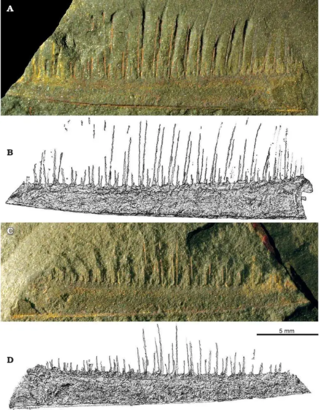
Pseudoangustidontus is a genus of hurdiid (peytoiid) radiodont from the Lower Ordovician of Morocco. This genus is known from two described species, P. duplospineus and P. izidigua, with some specimens that are hard to determine which species to belong to. This animal is only known from the Fezouata Formation, a fossil site in Morocco that is of Lagerstätte status, meaning that the fossils from this site are exceptionally preserved. Because of its partial remains, its classification was debated, but with more complete fossils it is identified as radiodont frontal appendage.

Aegirocassisinae is a subfamily of radiodonts from the lower Paleozoic era. It belongs to the larger hurdiidae (peytoiid) family, which were the most diverse and long lasting radiodonts. The members of this subfamily are restricted to the Lower Ordovician-aged Fezouata Formation of Morocco. Currently only two genera are included: Aegirocassis and Pseudoangustidontus. These two genera possess large Baleen-like auxiliary spines on their frontal appendages, which suggests a suspension feeding lifestyle for the group. These radiodonts are some of the few known from sediments beyond the Cambrian period. This subfamily shows that following the Great Ordovician Biodiversification Event, which saw a rise in the plankton population in the worlds oceans, suspension feeding became more common in radiodonts then other feeding styles. It also seems that due to the evolution of new predators, like large nautiloid cephalopods, and other arthropod groups like the eurypterids, the radiodonts evolved suspension feeding lifestyles in order to minimize competition for food.

Cordaticaris is a genus of extinct hurdiid (peytoiid) radiodont that lived in what is now northern China during the middle Cambrian period. This animal was described in 2020 based on remains found in the Zhangxia Formation, located in the Shandong Province. It is differentiated from other members of its family by its unique heart-shaped frontal sclerite, and its frontal appendages bearing nine endites and seven more elongated subequal endites. This animal was important as it was the first Miaolingian aged hurdiid known from rock layers outside of laurentia, allowing paleontologists to get a better grasp of this families geographic range in life.
























